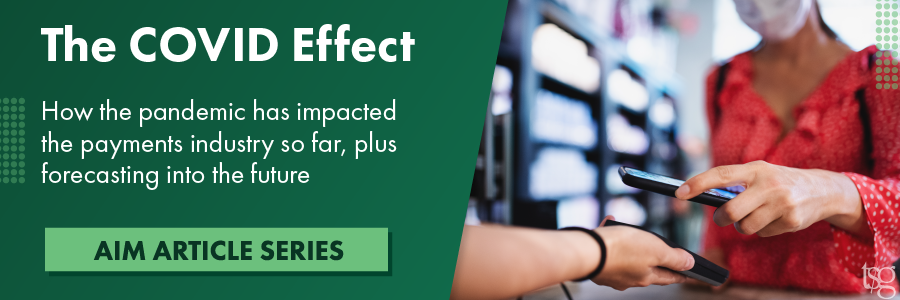
Planning for the future is a key factor in formulating short- and intermediate-term strategies. Considering past performance, which is not necessarily indicative of future performance, along with forecasting techniques should inform strategies, especially in volume-based industries such as payments. In the simplest of terms, more payments volume means more revenue. First, let’s focus on past performance. This article focuses on the impact of COVID-19 during 2020, the recovery in 2021, and forecasting into the future.
IMPACT
The market disruption in 2020 due to the global pandemic required companies to adapt quickly to regulations and changes in consumer spending. Each industry type was impacted uniquely. Leveraging TSG’s Acquiring Industry Metrics platform, monitoring 2020 impact from an industry-specific view provides clarity.
For example, date nights out turned into date nights spent at home. Movie Theatres and Babysitting Services decreased spending by -73% when comparing August 2020 to August 2019. It’s important to use an established, consistent baseline for comparison (See What Is Meaningful Data?). The impact on Movie Theatres and Babysitting Services is intuitive in hindsight but would have been difficult to predict in January 2020. Conversely, as individuals and consumers practiced social distancing in 2020, there was a demand for safe, outdoor activities. Where can one safely escape the confines of home (?), the open road and open water. Motor Home Dealers, Boat Dealers and Boat Rentals increased spending by +48%, +35%, and +34%, respectively.
The industry concentration mix within a merchant portfolio, along with the unique industry type impact, drove portfolio performance in 2020. You may think, “How is this different than any other time period?” In essence, the concept is not, but predictability is the challenge. Now with a baseline established, the next step is to monitor recovery.
RECOVERY
The next question to ask is, “How is the market recovering?” To measure recovery, we can compare August 2021 performance to August 2019. Notice that we are using the same baseline as measuring impact. Comparing 2021 performance to 2019 performance provides context into where we are today.
In the example of Movie Theatres, spending recovered to +30% (CAGR) in August 2021 compared to 2019. A positive value is an encouraging sign that Movie Theatre spending is recovering. Conversely, Baby Sitting services decreased -18% in 2021 compared to 2019. So, not only was Baby Sitting Services adversely impacted during 2020, it’s also slower to recover in 2021.
As we saw in our impact example, Motor Home and Boat Dealers were favorably impacted during 2020. Measuring their recovery, or in this case continued performance, in 2021 tells two different stories. Motor Home Dealers increased +13% in 2021 compared to 2019, whereas Boat dealers decreased -5%. Uncovering the more recent recovery affects the forecasting into the future.
HOW IMPACT AND RECOVERY COME TOGETHER
This article provides examples of adversely and favorably impacted industry verticals. For the adversely impacted industries, how much time of increased spending is required to make up for lost spending during depressed months of the pandemic? In our Movie Theatre example…
- The average adjusted monthly credit/debit card spend per location was $37,500 prior to March 2020.
- Over the next 15 months the monthly spend was $11,000 (-71%).
- Lastly from June 2021 to August 2021, the same measure was $50,500 (+35% compared to pre-pandemic spending).
Assuming the go-forward average spend remains at $50,500 each month, it will take 28 months to recover the lost volume from March 2020 through May 2021. This analysis could be completed for any industry over the same time period. Using this type of logic allows for a type of breakeven analysis.
FORECASTING
The last piece of the puzzle is to measure or forecast what’s going to happen. Unfortunately, the magic crystal ball does not exist. In the previous Movie Theatre example, a broad assumption was made that spending would remain at $50,500/month moving forward, but that was just to make a point. Go-forward spending will always be impacted by a myriad of predictable and unpredictable variables. Big data and data science have come leaps and bounds over time which gives payments companies more tools in their kit.
Staying close to timely performance metrics is critical. It is challenging to predict future industry performance until a baseline is established. Although a lagging indicator, monitoring impact and recovery provides the baseline of market performance. For payments companies, big data is at the heart of short- and intermediate-term strategies. Utilizing all available data to establish an Impact and Recovery baseline is the start to forecasting future performance.
TSG recently provided its AIM members a look at the impact and recovery of over 250 industries in its latest Market React report (members login here to download).
Working on a vertical-specific strategy? Let’s discuss some key insights from the report and talk about how AIM can help build your strategy for 2022.

By Josh Istas, Senior Director of Analytics